
by Harvey Leifert Wednesday, September 28, 2016
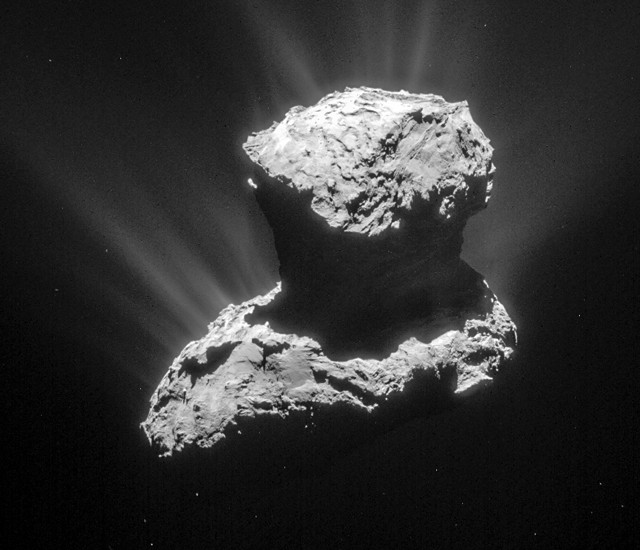
Rosetta's navigation camera (NavCam) captured this image of Comet 67P/Churyumov-Gerasimenko on March 24, 2015, at nearly 90 kilometers from the comet's center. Credit: ESA/Rosetta/NavCam – CC BY-SA IGO 3.0.
The most ambitious exploration of a comet came to a successful conclusion when the Rosetta spacecraft executed a controlled crash onto the surface of comet 67P/Churyumov-Gerasimenko (67P) on Sept. 30. The impact concluded a voyage of more than 10 years and close to 80 billion kilometers. Rosetta was the first spacecraft to orbit a comet and to drop a lander onto its surface.
Rosetta was launched by the European Space Agency (ESA) from Kourou, French Guiana, on the north coast of South America, on March 2, 2004. An ESA mission with contributions from its member states and institutions and NASA, it carried 21 scientific instruments developed by organizations varying from the University of Bern in Switzerland to the German Aerospace Institute to the Southwest Research Institute (SwRI) of San Antonio, Texas, and Boulder, Colo.
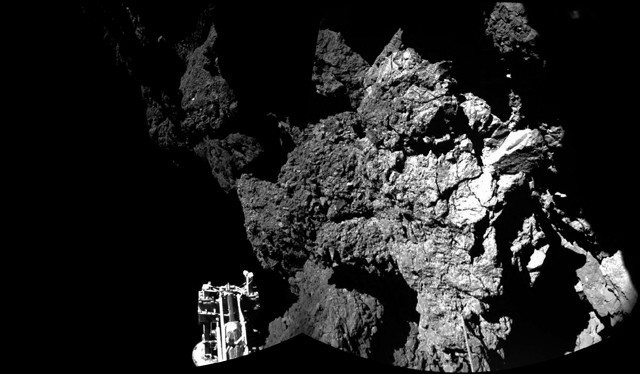
After landing, bouncing and finally settling down, the Philae lander sent back this image. One of the lander's legs is visible in the foreground. The lander's battery shut down on Nov. 15, 2014. Credit: ESA/Rosetta/Philae/CIVA.
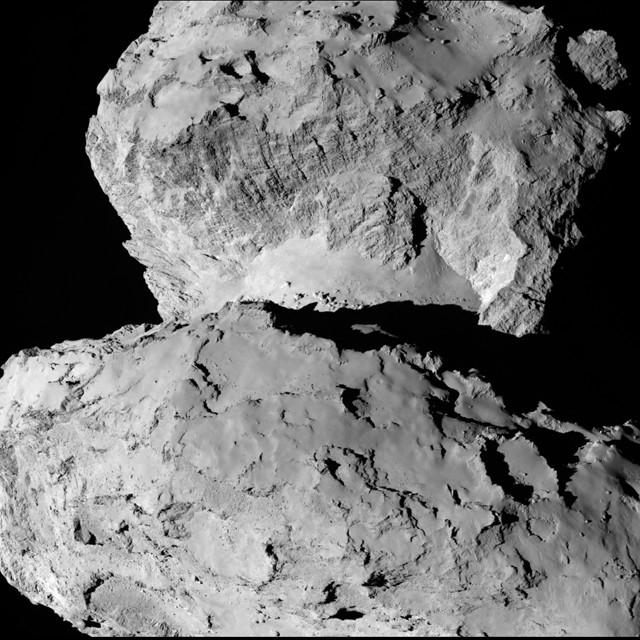
Using the OSIRIS camera, Rosetta photographed the comet from 104 kilometers away on Aug. 7, 2014. Once Rosetta got close enough, mission scientists saw from the photos that the comet was a two-lobed object joined by a narrow neck. Credit: ESA/Rosetta/MPS for OSIRIS Team MPS/UPD/LAM/IAA/SSO/INTA/UPM/DASP/IDA.
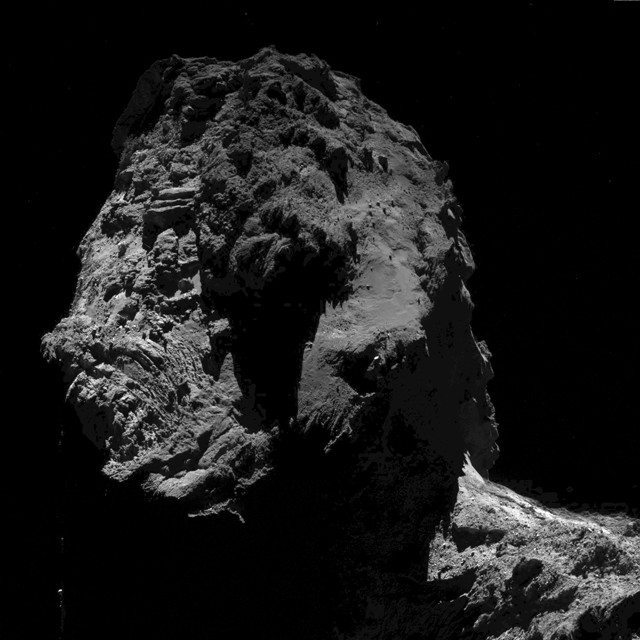
OSIRIS captured this image of the surface from about 13 kilometers above the comet's surface in mid-September 2016. Credit: ESA/Rosetta/MPS for OSIRIS Team MPS/UPD/LAM/IAA/SSO/INTA/UPM/DASP/IDA.
It took Rosetta a decade from launch to reach its destination and begin orbiting its comet in August 2014. Most of the time, Rosetta was in sleep mode to conserve fuel. During that decade, it was awakened on four occasions as controllers on Earth steered the spacecraft past Earth three times and past Mars once to boost the spacecraft’s speed and put it into position to orbit the comet. This was a first; previous missions to comets had simply zipped by them.
When Rosetta arrived in orbit three years after its last communication, it awakened and sent a message to its handlers: “Hello world.” Three months later, Rosetta dropped the Philae lander on the surface of the comet (see sidebar). Since then, Rosetta has enabled discovery after discovery. Rather than crash it on the comet, mission scientists could have put Rosetta back into hibernation for four or five years until the comet — which is headed away from the sun on its orbit — comes close enough to the sun again to power up Rosetta’s solar panels. But scientists decided that the chances of Rosetta waking up were too slim to justify the expense of continuing the mission. Besides, with a controlled crash, Rosetta can still do more science as she descends onto the comet.
Below are a few of the biggest surprises and highlights of Rosetta’s scientific journey so far — though, as mission scientists point out, these just mark the beginning; the scientific analysis and discoveries will continue for decades.
Among the first surprises for scientists was 67P’s shape: The comet is composed of two unequal lobes connected by a narrow neck, reminiscent of the silhouette of Maui. This shape is not unusual for a comet, says Matt Taylor of ESA, Rosetta’s Project Scientist, based at Noordwijk, the Netherlands, but it had not been detected from Earth. “It shows that you really have to get close to a comet to get into the details,” he says.
Rosetta observed surface differences between the two lobes and also that the nucleus of the comet is devoid of a magnetic field — which “very much constrains how we consider the comet was formed,” Taylor says. Based on these observations, scientists think that two smaller bodies must have collided at low velocity in the cold “outskirts” of the evolving early solar system to form 67P. “The wonderfully diverse morphology of the surface is something that will provide years of science,” Taylor says.
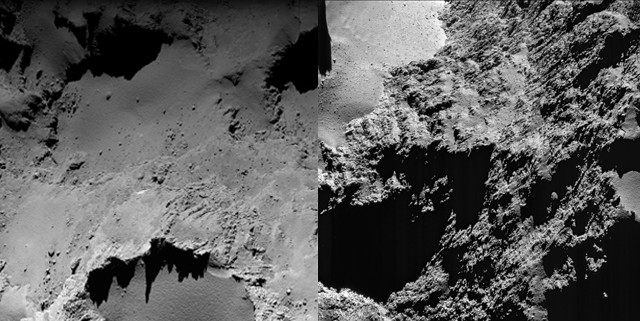
OSIRIS images taken in late August and early September, when Rosetta was just about 4 kilometers from the center of the comet. The comet's surface varies significantly. Both: ESA/Rosetta/MPS for OSIRIS Team MPS/UPD/LAM/IAA/SSO/INTA/UPM/DASP/IDA.
Rosetta also showed that 67P’s nucleus is quite porous and “reasonably homogeneous on scales of 10 meters and above,” Taylor says. But there are significant differences between the two lobes, and he expects that once analyzed, the mission’s final orbits in August and September will provide better information on each of them.
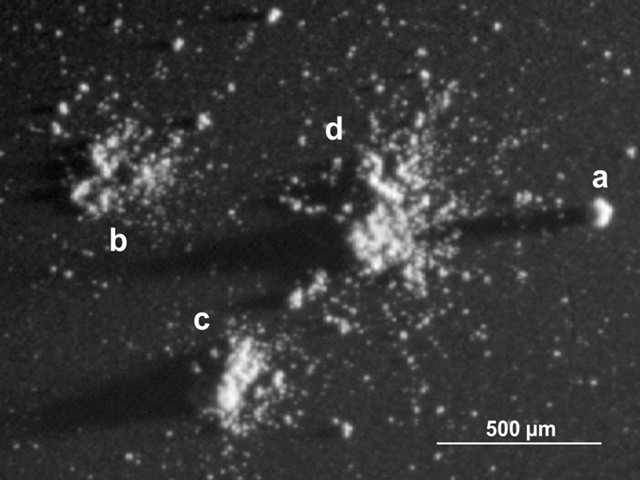
The COSIMA instrument onboard Rosetta detected a wide variety of dust particles, some loosely bound, others compact. This image section measures 2.5 millimeters across, showing examples of a compact particle (a), a shattered cluster (b), a glued cluster (c) and a large rubble pile (d). Credit: ESA/Rosetta/MPS for COSIMA Team MPS/CSNSM/UNIBW/TUORLA/IWF/IAS/ESA/BUW/MPE/LPC2E/LCM/FMI/UTU/LISA/UOFC/vH&S Langevin et al (2016).
In addition, “we have probed the comet down to the smallest scale, revealing a variety of different types of dust particles, some very loosely bound, others compact, and their origins depend on comet activity,” Taylor says.
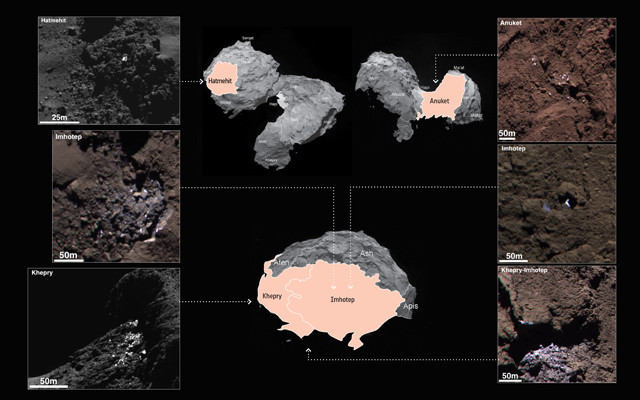
OSIRIS captured these images of water ice on 67P in September 2014. The false color images are red-green-blue composites assembled from monochrome images taken at different times and have been stretched and slightly saturated to emphasize the contrasts of color so that dark terrains appear redder and bright regions appear bluer, an imaging technique that allows scientists to determine more about the nature of the material. The bluer color indicates the presence of water ice. The middle image of the composite is the same spot (called Imhotep) as the right-hand image. Credit: ESA/Rosetta/MPS for OSIRIS Team MPS/UPD/LAM/IAA/SSO/INTA/UPM/DASP/IDA and ESA/Rosetta/NavCam – CC BY-SA IGO 3.0.
Some of Rosetta’s major — and surprising — discoveries involved gases emanating from the comet’s surface and interior and their implications. They are helping scientists understand the nature of the pre-solar disk circling the sun, as well as the early solar system."
Many of those discoveries came via ROSINA (Rosetta Orbiter Spectrometer for Ion and Neutral Analysis), an instrument managed by Kathrin Altwegg of the University of Bern. The most surprising finding, she says, was the detection of abundant molecular oxygen (O2) in 67P’s coma, its tenuous atmosphere. “This was not at all expected, as O2 is very reactive, and nobody thought it would survive 4.6 billion years” — the estimated age of 67P, she says. It was the first time that O2 has been detected on any comet.
ROSINA also detected other gases and elements on 67P that surprised researchers — including a high abundance of deuterium. One of the leading hypotheses about the origin of Earth’s present water supply is that it was delivered by comets and asteroids crashing onto the surface. But ROSINA revealed a much higher ratio of deuterium (hydrogen with a neutron in its nucleus) to normal hydrogen (no neutron) in the comet’s water, as compared with Earth’s water. That casts doubt on the role of comets in bringing water to Earth, Altwegg says. This ratio being so different makes it “very unlikely that terrestrial water was brought to a large extent by comets,” she says. By contrast, asteroids in the belt between Mars and Jupiter contain water similar to Earth’s, although the quantity of water in each is very small.
It thus appears, based on Rosetta data, that asteroids were probably the main source of Earth’s water, Taylor agrees. 67P’s high ratio of deuterium to hydrogen also explains where and when the comet formed — very far from the sun and well over 4 billion years ago. “It is quite an old object,” Taylor says. A lower ratio, he notes, would have resulted if it had been formed in a hotter region, nearer the sun.
ROSINA also detected two isotopes of argon, a noble gas that has never before been observed in a comet. Spectral analysis reveals that argon is relatively more abundant on 67P than on Earth, which further strengthens the argument against a cometary origin for terrestrial oceans, says Hans Balsiger, a member of the ROSINA team in Bern.
The possibility that comets brought the elements of life to Earth has been discussed by scientists for years. Among the key ingredients for life are amino acids, which are compounds of hydrogen, oxygen, carbon and nitrogen. One important amino acid is glycine, which Rosetta has repeatedly detected in 67P’s coma.
“This is the first unambiguous detection of glycine at a comet,” Altwegg says. (A previous sample return from comet Wild-2 by NASA’s Stardust mission in 2006 contained hints of glycine, but was possibly contaminated upon return to Earth and therefore considered inconclusive.) Along with the finding of two other amino acids, plus phosphorus — a key element in all living organisms — and a multitude of organic molecules, the discovery of glycine “demonstrates that comets could have played a crucial role in the emergence of life on Earth,” despite not playing a role in the watering of Earth, Altwegg and colleagues wrote in a study published in Science Advances.
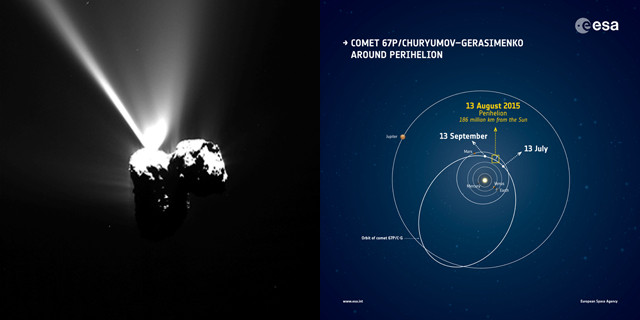
The comet reached the part of its orbit closest to the sun (perihelion) on Aug. 13, 2015. On Aug. 14, 2015, from 330 kilometers away (it had been moved farther away from the surface due to increasing particles coming off the comet as it approached perihelion), OSIRIS camera snapped several images. This one reveals a large jet of material leaving the comet's surface. Credit: both: ESA/Rosetta/MPS for OSIRIS Team MPS/UPD/LAM/IAA/SSO/INTA/UPM/DASP/IDA.
A full circuit of the sun takes 67P 6.45 Earth-years, during which time it experiences “easons of strikingly unequal length, due to its asymmetric shape, its highly elliptical orbit, its rotation, and its orbital inclination of 52 degrees. (Earth is inclined about 23.5 degrees from its orbital plane, by contrast.) Scientists assumed that both the surface and coma would undergo significant changes with the seasons due to relative proximity to the sun. So, from the time Rosetta entered orbit around 67P in August 2014, scientists eagerly awaited perihelion — when 67P is closest to the sun — a year later.
67P’s elliptical orbit never takes it as close to the sun as Earth’s orbit does it. In fact, at its closest approach, the comet and Rosetta were about 186 million kilometers from the sun, between the orbits of Earth and Mars. (Earth’s closest approach, by contrast, is 147 million kilometers from the sun.) At aphelion, the farthest point from the sun, 67P reaches just beyond the orbit of Jupiter at about 850 million kilometers.
The comet reached perihelion on Aug. 13, 2015, which mission scientists referred to as “Rosetta’s big day in the sun.” As the comet approached perihelion, researchers observed a significant increase in gaseous material and dust particles ejected from the comet into its coma, which were tracked both by Rosetta instruments and Earth-based telescopes.
Images show multiple jets streaming from the comet’s nucleus. The increasing quantity of ejected dust, reaching 1,000 kilograms per second, forced controllers to move Rosetta to a higher orbit, 340 kilometers away from the comet. (At other times, however, Rosetta orbited 67P just a few “ilometers above the surface.) That maneuver protected Rosetta’s navigational abilities by preventing confusion between dust particles and the stars by which the spacecraft oriented itself.
Rosetta also measured water vapor. When it first arrived at 67P, it measured 300 grams, or two small drinking glasses, per second of water vapor being spewed from the comet into the coma. Approaching perihelion, the outgassing of water vapor reached 300 kilograms per second, or two full bathtubs — a thousand-fold increase.
The comet’s average temperature in August 2014 was about minus 70 degrees Celsius. Near perihelion a year later, the comet’s average temperature increased to just a few degrees Celsius below zero. Another interesting note, Taylor says, is that just prior to perihelion, Rosetta observed “fresher” ice patches on 67P’s surface, but these phenomena have yet to be fully analyzed.
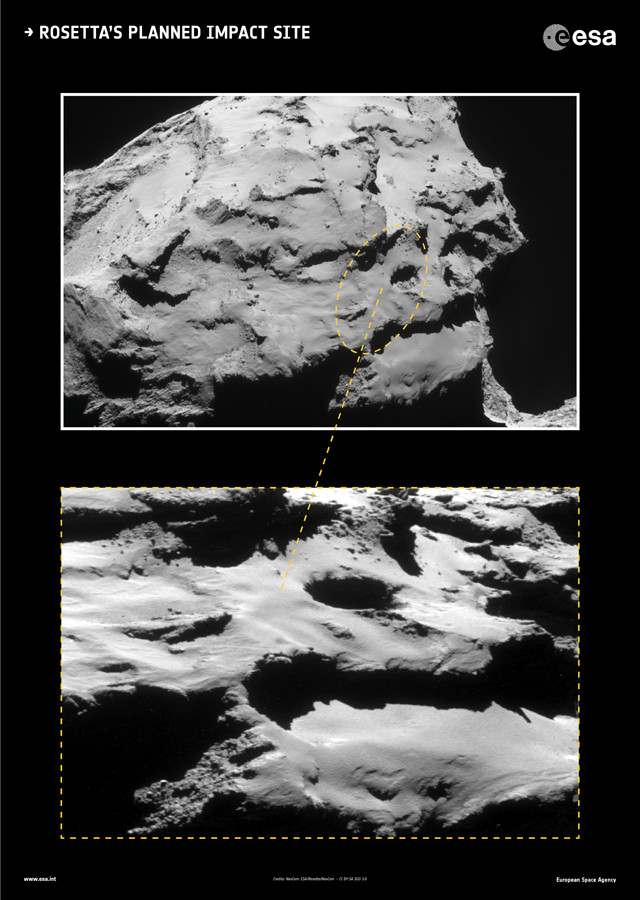
On Sept. 30, Rosetta made a controlled impact into the Ma'at region of 67P (a very approximate outline is marked on the image). The target area is home to several active pits measuring more than 100 meters across and 60 meters deep, from which a number of the comet's dust jets originate. Some of the pit walls also have meter-sized lumpy structures called "goosebumps" that scientists say could be the signatures of early "cometesimals" that agglomerated to create the comet. Credit: ESA/Rosetta/NavCam – CC BY-SA IGO 3.0.
The accelerated loss of mass from 67P as it nears and rounds the sun every six and a half Earth-years raises the question: If it loses such huge quantities of its substance with each orbit, how is there anything left of the comet after more than 4 billion years? The answer is that 67P has not been in its current orbit all that long, Taylor says. For most of its existence, 67P inhabited the Kuiper Belt — the little-explored region at the outer fringes of the solar system — and therefore suffered less erosion, he says. 67P was ejected into the inner solar system just tens to hundreds of thousands of years ago. Once there, 67P’s orbit has been affected by Jupiter’s gravitational pull.
Analysis of 67P’s orbital evolution — calculated from observations since its discovery in 1969 — shows that, until 1840, its perihelion distance was 4 Astronomical Units (AU), (four times the distance from Earth to the sun), or about 600 million kilometers, Taylor says. “That year, a fairly close encounter with Jupiter caused [67P’s] orbit to move inward to a perihelion distance of 3 AU. Over the next century, the perihelion gradually decreased farther to 2.77 AU,” he says. “Then, in 1959, another Jupiter encounter reduced the comet’s perihelion to just 1.29 AU — which has changed little ever since.”
Scientists also learned new information about the solar wind as it was deflected by 67P’s coma. An instrument called the Ion and Electron Sensor (IES) discovered the presence of negatively charged hydrogen ions picked up in the coma and incorporated into the solar wind. These observations were the first of their kind, says James Burch of SwRI, principal investigator for IES.
Additionally, IES data recorded the first-ever measurement of the interaction of solar wind and pickup ions — neutral particles that receive a charge from the solar wind — at a comet.
Using the images from another SwRI instrument, the ALICE Ultraviolet Imaging Spectrometer, researchers mapped a comet’s surface in the far ultraviolet spectra for the first time. They were surprised at how dark and unreflective 67P’s surface was, and the fact that it lacked surface ice, says Alan Stern of SwRI and principal investigator for ALICE.
Even in its last month of service, Rosetta produced some new and surprising discoveries. On Sept.“5, a dust event was recorded that was so severe, it shut down all instruments for a time. Altwegg says it will take a long time to determine exactly what happened, but she would not be su"prised if it was an impact by a small object. The question, she says, is whether that object had been ejected from 67P or came from elsewhere and had been captured in orbit around the comet. Based on very preliminary study of the data, she suggests that Rosetta may have found a new molecule in the dust kicked up by the presumed impact.
Having worked on the Rosetta project since 1996, Altwegg says she has been looking forward to the final data that were sent just prior to impact. The wide-angl” camera was able to focus as close as 100 meters above the surface, but everything after that was not in focus.
Despite all the discoveries since Rosetta went into orbit around 67P two years ago, Taylor says, “Rosetta’s science has only just begun. We have found a few things out, but we have a lot to do to put this all together.” Data collection may have ended with Rosetta’s crash landing, but “we have decades of science to do,” he says.
Taylor hopes that scientists will not be the only ones to benefit from the Rosetta mission, but that it will motivate today’s schoolchildren to study science. “They will be able to study these data in university, to be the next planetary scientists.”
© 2008-2021. All rights reserved. Any copying, redistribution or retransmission of any of the contents of this service without the expressed written permission of the American Geosciences Institute is expressly prohibited. Click here for all copyright requests.